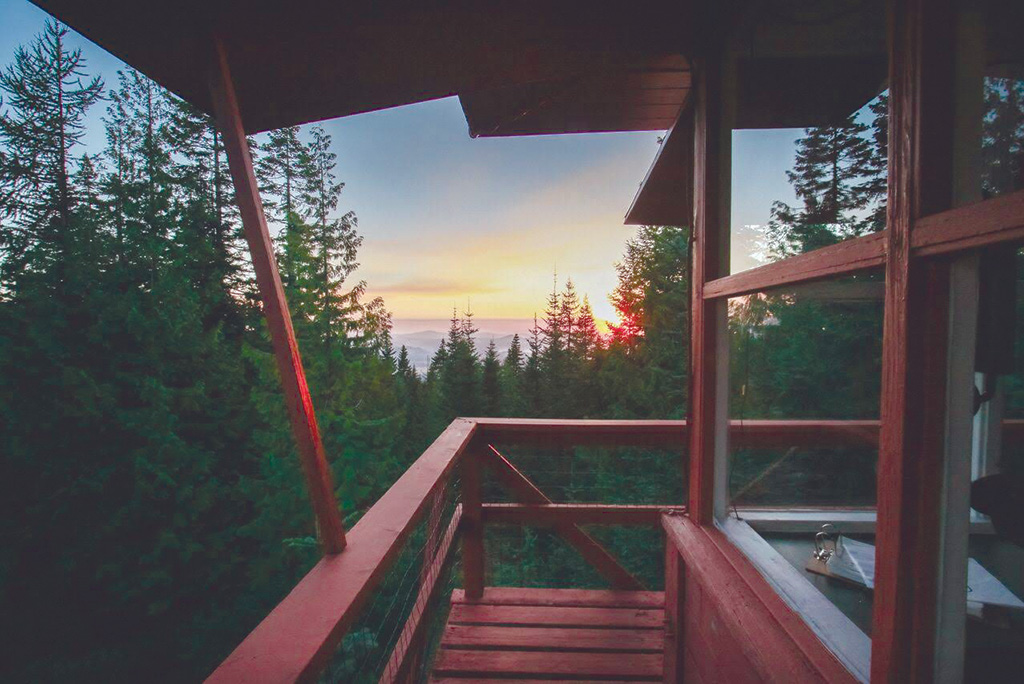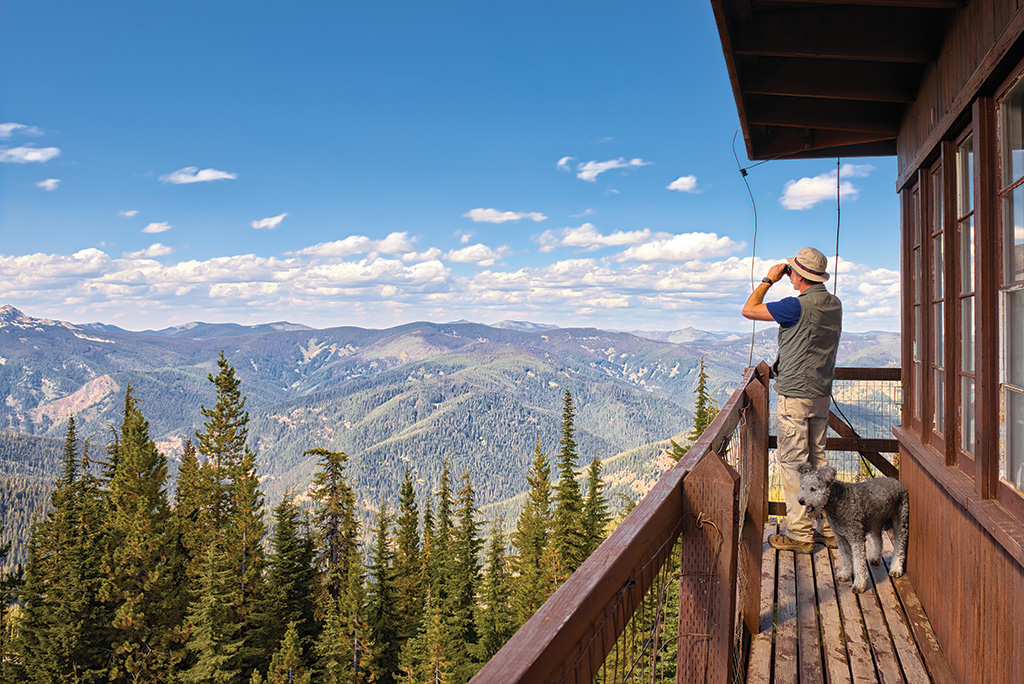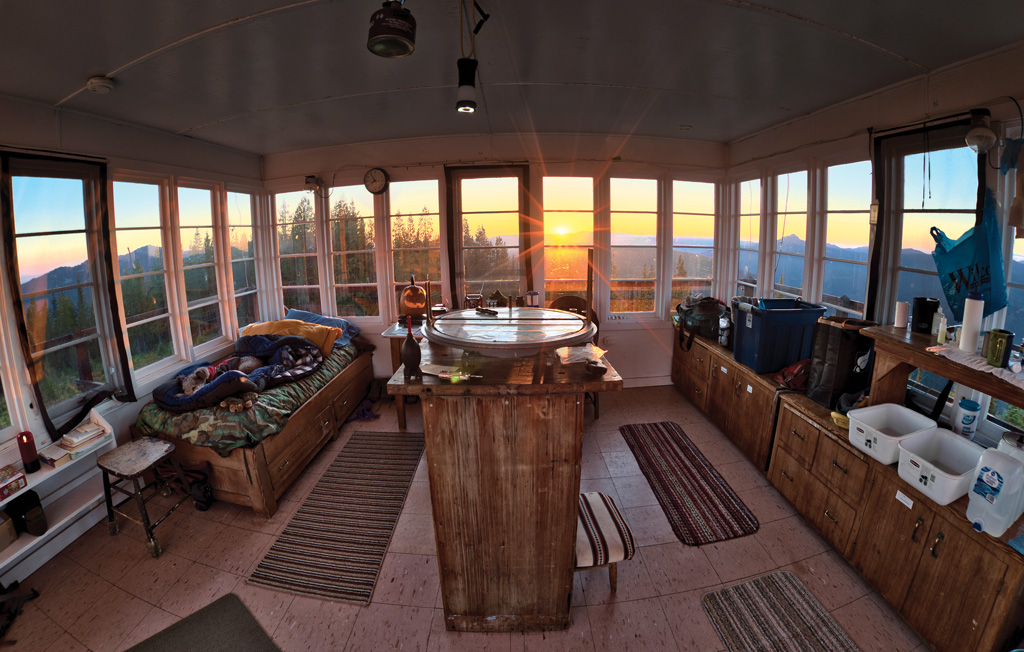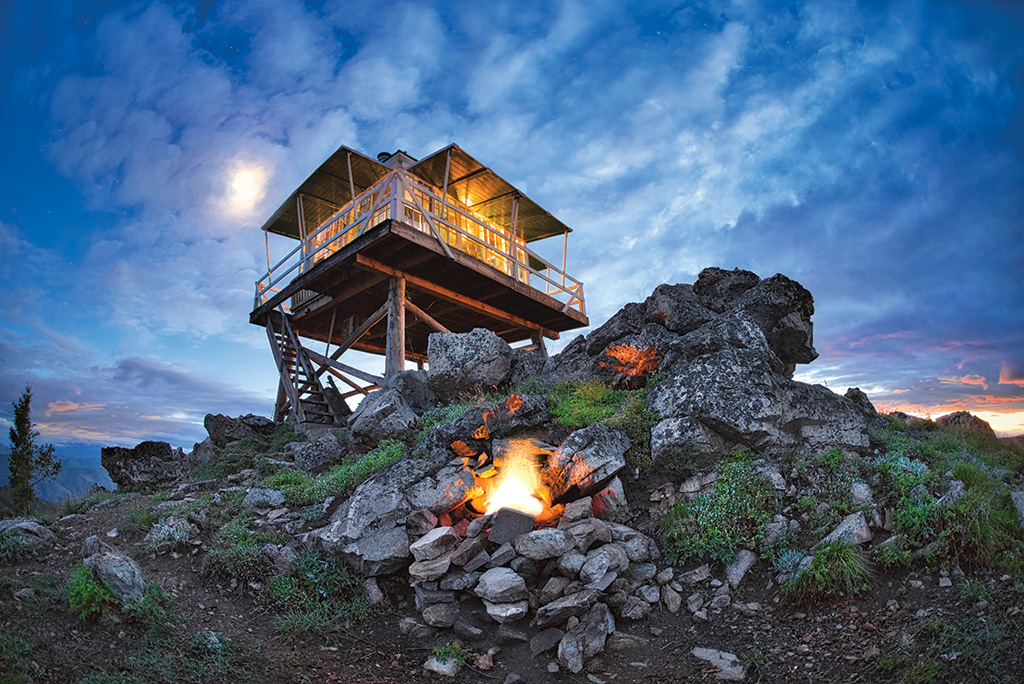Romantic. Wild. Untouched. Fire lookouts offer a remote and off-grid respite, with miles upon miles of jagged mountain lines marching across the horizon in ragged unbroken views. Unplug and roll back the clock to experience life like Jack Kerouac or Edward Abbey, both of whom spent time in the wilderness employed as fire lookouts and went on to write about it in popular works like Kerouac’s The Dharma Bums and Desolation Angels, and Abbey’s Black Sun.
Kerouac, who spent 63 days as a fire lookout on Desolation Peak in the summer 1956, recalls his first morning: “It was beautiful blue sunshine sky and I went out in my alpine yard and there it was. . . hundreds of miles of pure snow-covered rocks and virgin lakes and high timber, and below, instead of the world, I saw a sea of marshmallow clouds flat as a roof and extending miles and miles in every direction, creaming all the valleys…”

Gird Point Lookout at sunrise
What outdoor enthusiast or nature lover wouldn’t want to experience the natural beauty, wildlife viewing and staggering vistas offered from a remote perch on top of the world? Many fire lookouts are now available for overnight rental, affording almost anybody the opportunity to watch an afternoon storm gather around the edges to break in waves across an open valley. Designed to offer panoramic views, these windows on the world allow campers to enjoy a basket of stars tossed into a midnight sky or the glow of sunrise seeping golden, then peach, and dripping across ridgelines and mountain peaks to meet the blue of a high alpine sky.
Idaho, and the areas along its border with Montana and Oregon, offer more fire lookout rentals than any other area in the nation. In fact, the Forest Fire Lookout Association (FFLA) lists Idaho as having the highest total lookout sites of any state in the nation (966 total). Not all of Idaho’s original lookouts are still standing and many are no longer staffed full time, which means that those looking for adventure can hike to or even book overnight rentals at these remote mountaintop sites for a unique and unforgettable backcountry experience.

The queen bed with linens at Crystal Peak Lookout
The nation’s system of fire lookouts developed after the devastating 1910 forest fires that ripped through Idaho, Montana and Washington, known as The Great Fire, and responsible for consuming 3 million acres of prime virgin timber and killing 86 people. The Great Fire of 1910 destroyed enough timber to fill a freight train 2,400 miles long and blocked out daylight, blackening skies as far north as Saskatoon, Canada, and as far east as Watertown, New York. This disaster provided the impetus for an organized fire lookout network as well as better trail and communications systems. By the late 1930s, over 5,000 fire lookout towers had been constructed, many of them built by the Civilian Conservation Corps (CCC), also known as President Roosevelt’s “tree army.”
The fire lookouts served as an organized fire reporting system for early detection and were staffed by individuals who communicated via heliograph (a device using two mirrors to reflect sunlight and send messages via Morse code), then later by telephone wired to the remote outposts, using single strands of galvanized wire strung from tree to tree up the steep mountain slopes, and eventually, by portable radios. Early fire spotters served as “smoke chasers” by fighting fires with tools they could carry on foot or by horse, building early fire lines with shovels, pulaskis and axes.

The view from the deck at Crystal Peak Lookout
More recently, the development of infrared detection devices and the deployment of airplanes and helicopters means that the lookout system is still utilized, but to a much lesser extent. By the 1950s, only a few hundred fire lookouts were still in service, and in the last several decades, many fire lookouts have been officially decommissioned; with some maintained as scenic vista points for visitors by the U.S. Forest Service (USFS) and others being available for shorter overnight stays. A few are accessible by road, while others can be reached only by trails across more rugged terrain with supplies that must be brought in by pack trains or on sleds and skis.
Fire lookouts and outposts are available on a first-come, first-served basis and may be rented through the National Recreation Reservation System (NRRS) online at recreation.gov for around $45 to $55 per night. Some of the more spectacular win Idaho and along its borders include Little Guard Lookout, perched at an elevation of 6,031 feet and boasting spectacular views overlooking the North Fork of the Coeur d’Alene River, Downey Peak and the Bitterroot Mountains; as well as Castle Butte Lookout near Lowell, Idaho, set on a rocky point at 6,659 feet with views of the Seven Devils and Selway-Bitterroot Wilderness; or Bald Mountain Lookout near Potlatch, Idaho, with sweeping views of the honey-colored rolling hills of the Palouse region. Both Arid Peak Lookout and Surveyors Lookout, near Avery, Idaho, are listed on the National Historic Register and feature spectacular panoramic views of the surrounding mountains, as well as access to blue-ribbon cutthroat trout streams and wildlife viewing for elk, deer, moose, eagles and falcons. And just over Idaho’s eastern border in Montana, Gird Point Lookout rests at 7,702 feet with 360-degree views of the surrounding Sapphire, Bitterroot and Anaconda Pintler mountains, while Up Up Lookout, just 30 minutes from Wallace, Idaho, offers a 40-foot tower on a beautiful rock pinnacle in the Bitterroot Mountains of western Montana.

View from Surveyors Lookout outside deck
A few, such as Crystal Peak Lookout, are privately owned and available for rental year-round and come with extra amenities like a sauna and wood-burning stove, a queen bed with full linens, towels, outdoor fire pit, stove and coffeemaker. Billed as an “immersive deep-forest getaway for adventurous couples,” the Crystal Peak Lookout is definitely a luxury fire lookout rental experience—remote and pristine, but most certainly an upgrade from your typical fire lookout overnight.

Interior of Gird Point Lookout at sunrise
A fire lookout is basically a small wooden structure with glass windows that reveals 360-degree views, designed to provide fire detection for anywhere from 20 to 100 miles away. Some are accessible via dirt or gravel roads (four-wheel drive vehicles) and many more are only accessible via hiking trails (anywhere from.5 to 2 or 3 miles). Most of the lookout facilities are rustic and primitive in nature due to their remote locations—situated on top of mountain peaks and located in rocky outcroppings lacking modern conveniences of electricity or piped-in water. But all offer the opportunity to unplug and unwind, with a special invitation to enjoy the spectacular beauty of the surroundings at a much slower pace.


